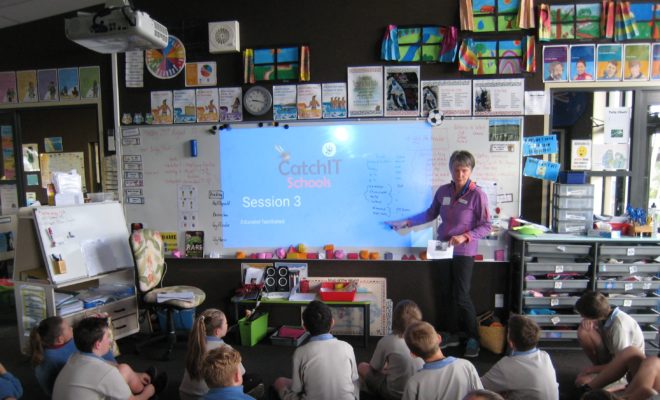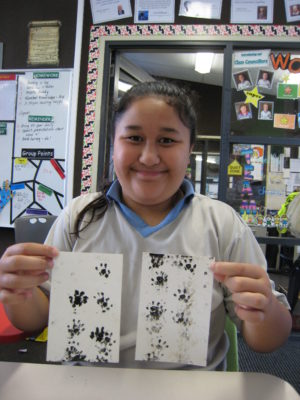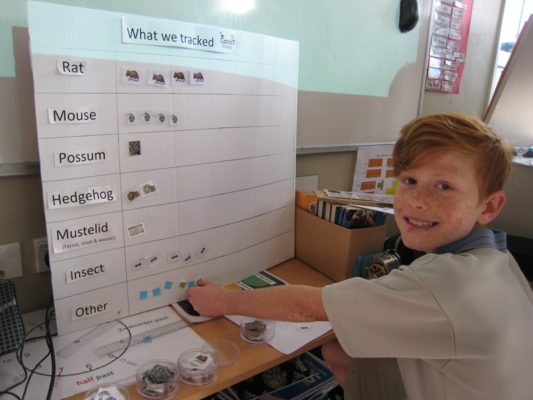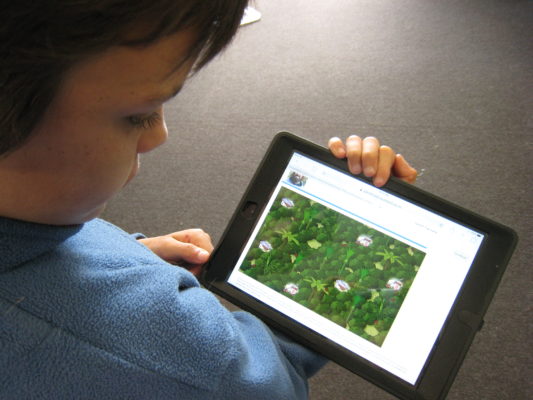Got a ferret you’re struggling to trap? How about using a milk bottle top filled with milk for a lure? It worked a treat for one child taking part in the Forest Bridge Trust’s award-winning CatchIT schools programme. “Children are natural innovators,” says Liz Maire, educator for the Trust. “Some of them have discovered things that are teaching me. Children dare to be different. One girl lured a rat into her tunnel trap with bread soaked in rum.”

The Forest Bridge Trust has taken its CatchIT schools programme into 14 schools since 2015, in some cases running the programme more than once in a school.
“We have two more schools to visit next year and then we’ll have covered all the schools in our strategic area of ‘Northern Rodney, from Kaipara to the East Coast,” says Liz.
The conservation education efforts of the Trust were recognised recently when they received the Schools Award (sponsored by Predator Free NZ Trust), in the Auckland Council Mayoral Conservation Awards. The Schools Award recognises collaboration and innovation – something the CatchIT programme has in spades!

“CatchIT is a community trapping records app that was developed by the Statistics Department at Auckland University,” Liz explains. “They did a simpler version as a statistics and science pilot for schools and it was serendipity that we came across it.”
The Forest Bridge Trust and CatchIT have worked closely together since then, with all the data from the school trapping programmes stored and analysed through the CatchIT app. Liz runs the CatchIT Schools programme over a single term, for the year 5-8 level.
“I go into the school four times over the term and also run a parents evening workshop so that parents are up to speed with what we’re doing in the classroom and what the children are being asked to do at home.”
Liz begins with talking to the children about things that are special about our animals and plants.
“We talk about ‘endemic’ and ‘taonga’ and why our endemic taonga are under threat. The children define what a pest is and then they find out what is in their own backyard using tracking tunnels. They become detectives and then they take action with trapping.”
The children use snap traps in their own backyards.
“They’re each given two rat and two mouse traps and I talk ‘safety’ to them as if they are adults,” says Liz. “I tell them your responsibilities are to keep safe and to be humane. The parents also get a DOC 200 and a Timms trap if they attend the after school workshop, ensuring they know how to supervise their children safely with these more powerful tools.”
The next part is where statistics and science comes in as Liz works with the children on the practicalities of trapping and recording results.

“Finally we analyse the data using the online CatchIT app and generate bar-graphs of the results,” says Liz. “Children are natural innovators and good at statistics,” she believes. “They’re natural at seeing it.”
The programme ends with forming a conclusion about whether the trapping approach worked.
“At the end we hope they’ll carry on,” says Liz, “that we’ve lit a fire. It’s not about filling the bucket – it’s lighting the fire! I try to make sure they’re keen and want to carry on. We’ve had good success at some schools where they’re formed a trapping team at the end of the CatchIT programme.”
“We talk about why pests come into a trap and how we can make it inviting,” says Liz. “We predict what will happen with a certain bait, trialling the prediction and what is a fair test.”
Gathering data comes next and the children have a data sheet to fill in.
Members of the Snells Beach school trapping team showed Liz around their traplines when she revisited the school a while back.
“We had an entourage following us around and I asked the girl showing me, how often they checked the traps,” recalls Liz. “She answered, ‘Every break. We don’t go playing any more. We go trapping!’”

Trapping predators can extend beyond the science and statistics subject areas into other areas of the curriculum too.
“One school is designing and making traps out of recycled materials as part of their technology programme,” says Liz. “They had a ‘Show and Tell’ after school and I was invited along. The subject of pest control covers the whole learning spectrum – maths, science, art, letter-writing…”
The ‘real-world’ lessons also resonate with children.
“The reason why children take to it so well and enjoy the trickiest part – the statistics – is because it’s authentic,” Liz explains. “Its their data and it means something to them. It brings learning alive. We’ve had nearly 1000 children through the programme and two thirds have told us they’re going to carry on. We’ve got a lot of families trapping as well. If you get good buy-in and the parents do it, then the children will continue.”
Sometimes the influence of the Forest Bridge Trust CatchIT Programme extends well beyond the primary school classroom where those first lessons were carried out.
“One boy, Ziggy, who featured in a trapping programme at Matakana School has now gone on to Mahurangi College where he and some others have set up a trapping team,” says Liz. “They’re now influencing other kids too.”
In his project to ‘make a difference in your community’, Ziggy initially wanted to give out traps at the local market and approached Liz about getting some traps.
“I said to Ziggy that we need a way to tell our story,” says Liz, “And he replied, ‘I could make a video’. I thought it would be something amateurish,” Liz admits, “But a father of one of Ziggy’s friends is Peter Young and he agreed to do it for free. Ziggy spent a year producing the 4 minute video.”
The ripples of influence just keep expanding and expanding – a very rewarding outcome for Liz as an educator and for everyone backing the project at Auckland University’s Statistics Department and the Forest Bridge Trust. Liz would love to see that influence spread beyond the Trust’s own ‘North Rodney’ patch.
“I’m happy to share our curriculum links and notes,” she says.
You can contact Liz, via the Forest Bridge Trust at: [email protected]

